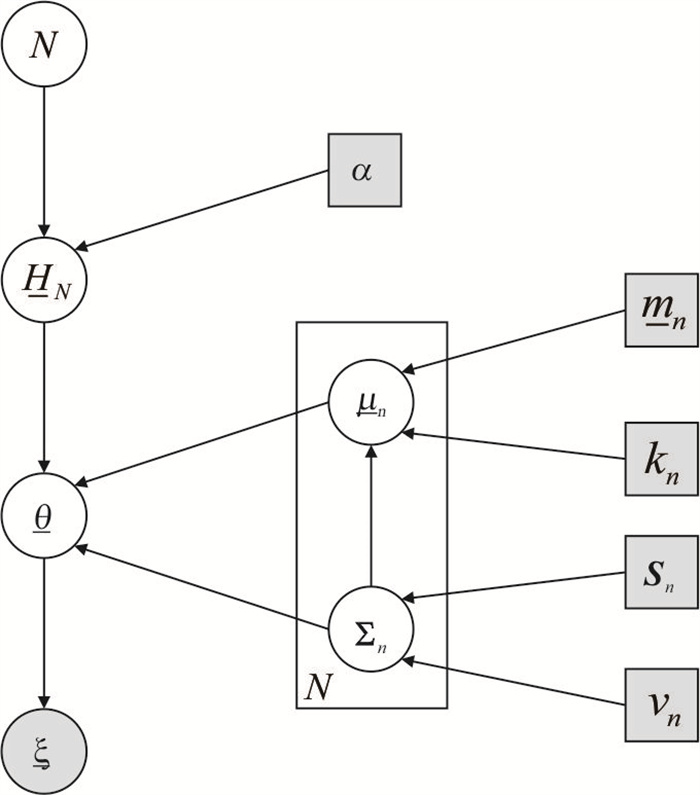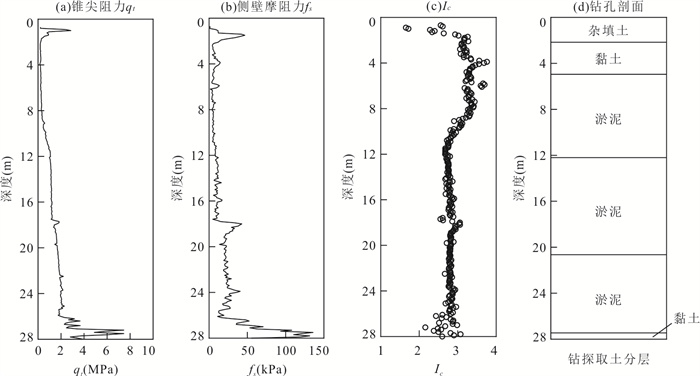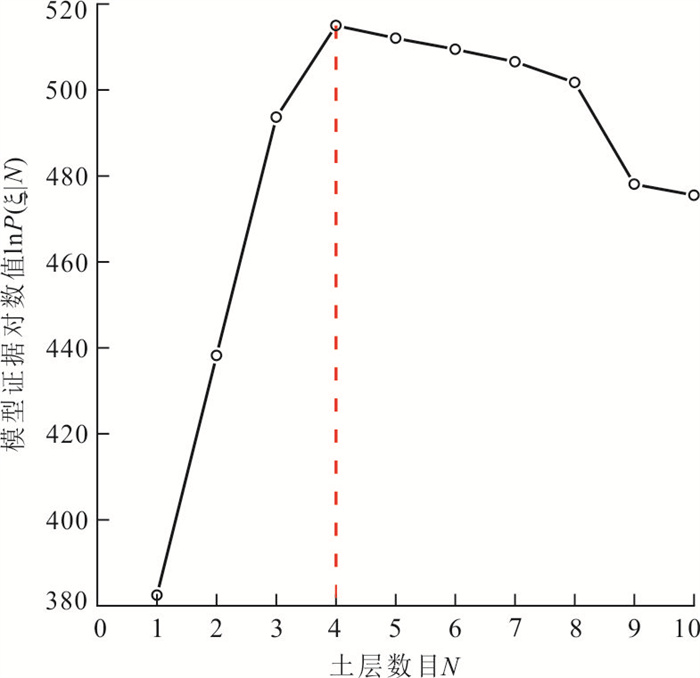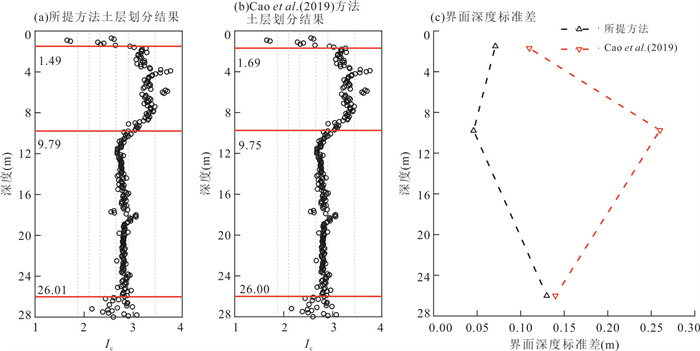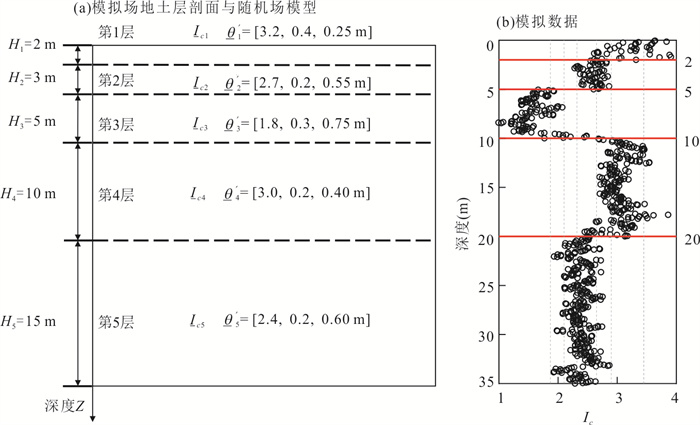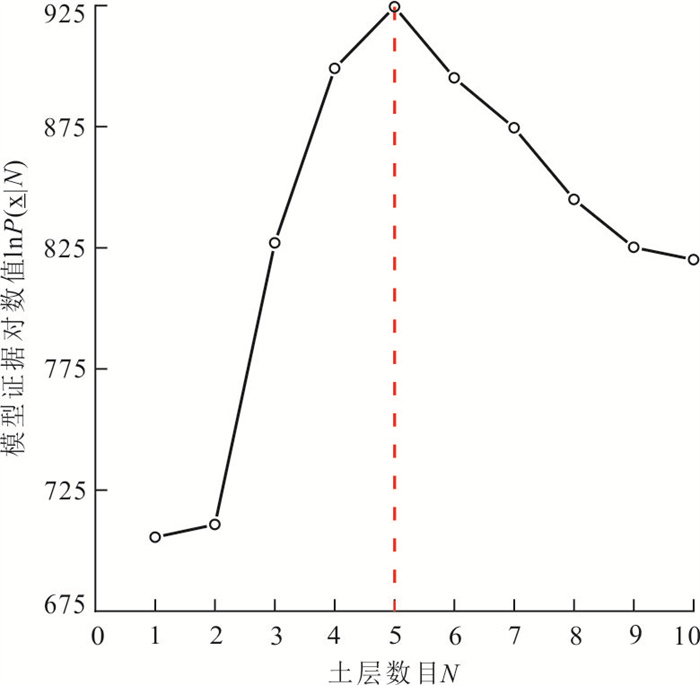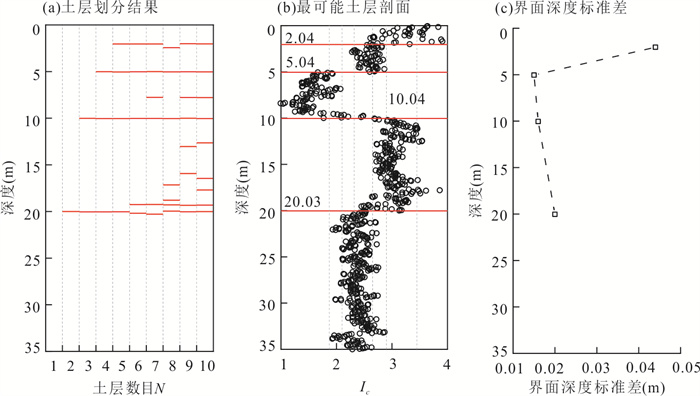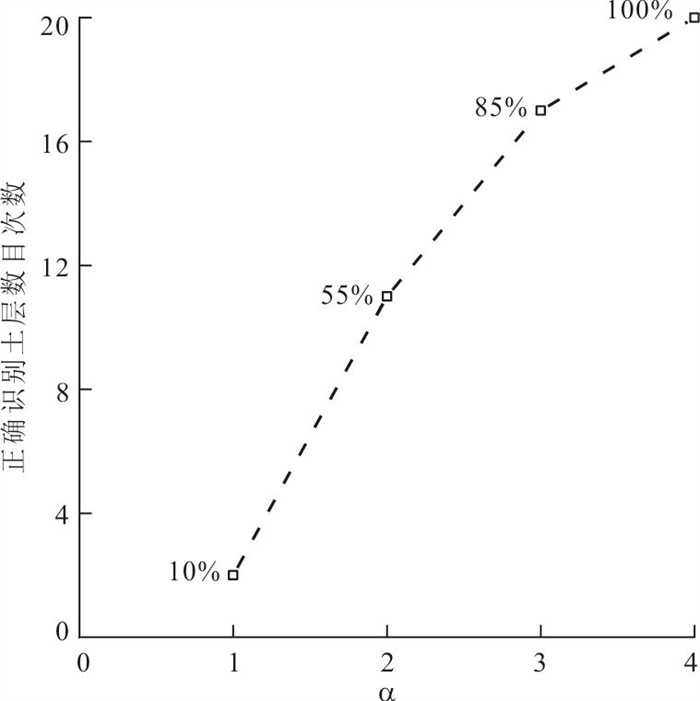Efficient Identification Method of Coastal Soft Soil Stratum Based on Hierarchical Bayesian Learning
-
摘要: 基于静力触探试验数据划分土层依赖于经验图表和主观判断,划分的土层剖面不可避免地存在不确定性.提出了一种基于土体分类指数Ic的土层界面快速识别和不确定性量化方法.在分层贝叶斯学习框架下,所提方法采用全高斯概率模型表征土体空间变异性,通过引入正态‒逆威沙特共轭分布实现似然函数的快速计算,高效求解模型证据,识别最可能土层数目和厚度.所提方法基于Ic的统计特性自动划分土层,提高了识别结果的可靠性.Abstract: Underground stratification based on the cone penetration test (CPT) data relies on empirical charts and subjective judgments. Uncertainties in soil profile identified from CPT data are unavoidable. In this paper it proposes a fast underground stratigraphy identification method based on soil classification index Ic, which also quantifies the identification uncertainty. Under the hierarchical Bayesian learning framework, the proposed method uses full Gaussian random field model to characterize the spatial variability of soils, and efficiently calculates the likelihood function of soil layer thicknesses given a soil layer number by introducing the Normal-Inverse Wishart conjugate distribution. By this means, the model evidence can be solved efficiently, and the most possible profile is identified. The proposed method automatically identifies the most probable soil layer profile considering the statistical characteristics of Ic, and improves the reliability of the identification results.
-
表 1 基于土类指数Ic的土体分类(刘松玉等,2013)
Table 1. Soil classification based on the soil behavior type index $ {I}_{c} $ (Liu et al., 2013)
土类指数$ {I}_{c} $范围 土体类型 分区 < 1.87 中砂 7 1.87~2.10 细砂 6 2.10~2.32 粉砂 5 2.32~2.65 粉土 4 2.65~2.90 粉质黏土 3 2.9~3.45且$ {Q}_{tn} > 11.8\mathrm{e}\mathrm{x}\mathrm{p}(-{F}_{r}/1.15)-0.36 $ 黏土 2 > 3.45或$ {Q}_{tn} < 11.8\mathrm{e}\mathrm{x}\mathrm{p}\left(-{F}_{r}/1.15\right)-0.36 $ 淤泥或淤泥质土 1 -
Ahmadi, M. M., Robertson, P. K., 2005. Thin-Layer Effects on the CPT qc Measurement. Canadian Geotechnical Journal, 42(5): 1302-1317. https://doi.org/10.1139/t05-036 Betz, W., Papaioannou, I., Beck, J. L., et al., 2018. Bayesian Inference with Subset Simulation: Strategies and Improvements. Computer Methods in Applied Mechanics and Engineering, 331: 72-93. https://doi.org/10.1016/j.cma.2017.11.021 Bishop, C. M., 2006. Pattern Recognition and Machine Learning. Springer, New York, 76-78. Bozorgzadeh, N., Harrison, J. P., Escobar, M. D., 2019. Hierarchical Bayesian Modelling of Geotechnical Data: Application to Rock Strength. Géotechnique, 69(12): 1056-1070. https://doi.org/10.1680/jgeot.17.P.282 Cai, G. J., Liu, S. Y., Tong, L. Y., et al., 2009. Soil Classification Using CPTU Data Based upon Cluster Analysis Theory. Chinese Journal of Geotechnical Engineering, 31(3): 416-424 (in Chinese with English abstract). http://www.cqvip.com/QK/95758X/20093/29811796.html Cao, Z. J., Wang, Y., 2013. Bayesian Approach for Probabilistic Site Characterization Using Cone Penetration Tests. Journal of Geotechnical and Geoenvironmental Engineering, 139(2): 267-276. https://doi.org/10.1061/(ASCE)GT.1943-5606.0000765 Cao, Z. J., Zheng, S., Li, D. Q., 2019. Bayesian Identification of Soil Stratigraphy Based on Soil Behaviour Type Index. Canadian Geotechnical Journal, 56(4): 570-586. https://doi.org/10.1139/cgj-2017-0714 Chen, L., Lin, W. B., Chen, P., et al., 2021. Porosity Prediction from Well Logs Using Back Propagation Neural Network Optimized by Genetic Algorithm in One Heterogeneous Oil Reservoirs of Ordos Basin, China. Journal of Earth Science, 32(4): 828-838. https://doi.org/10.1007/s12583-020-1396-5 Chen, Y. H., 2020. Variability Analysis of Undrained Shear Strength of Coastal Soft Soil (Dissertation). Southeast University, Nanjing (in Chinese with English abstract). Ching, J., Wang, J. S., Juang, C. H., et al., 2015. Cone Penetration Test (CPT)-Based Stratigraphic Profiling Using the Wavelet Transform Modulus Maxima Method. Canadian Geotechnical Journal, 52(12): 1993-2007. https://doi.org/10.1139/cgj-2015-0027 DiazDelaO, F. A., Garbuno-Inigo, A., Au, S. K., 2017. Bayesian Updating and Model Class Selection with Subset Simulation. Computer Methods in Applied Mechanics and Engineering, 317: 1102-1121. https://doi.org/10.1016/j.cma.2017.01.006 Frühwirth-Schnatter, S., 2006. Finite Mixture and Markov Switching Models. Springer, New York, 141-143. Guan, Z., Wang, Y., 2022. CPT-Based Probabilistic Liquefaction Assessment Considering Soil Spatial Variability, Interpolation Uncertainty and Model Uncertainty. Computers and Geotechnics, 141: 104504. https://doi.org/10.1016/j.compgeo.2021.104504 Hegazy, Y. A., Mayne, P. W., 2002. Objective Site Characterization Using Clustering of Piezocone Data. Journal of Geotechnical and Geoenvironmental Engineering, 128(12): 986-996. https://doi.org/10.1061/(ASCE)1090-0241(2002)128:12(986) Huang, K., Sun, R. L., Yuan, S. Q., et al., 2022. Effect of Number of Pumping Tests and Prior Information on Hydraulic Conductivity Estimation of Three-Dimensional Heterogeneous Aquifer. Earth Science, 47(2): 689-699 (in Chinese with English abstract). Jefferies, M. G., Davies, M. P., 1993. Use of CPTu to Estimate Equivalent SPT N60. Geotechnical Testing Journal, 16(4): 458-468. https://doi.org/10.1520/gtj10286j Ku, C. S., Juang, C. H., Ou, C. Y., 2010. Reliability of CPT Ic as an Index for Mechanical Behaviour Classification of Soils. Géotechnique, 60(11): 861-875. https://doi.org/10.1680/geot.09.P.097 Liu, S. Y., Cai, G. J., Zou, H. F., 2013. Practical Soil Classification Methods in China Based on Piezocone Penetration Tests. Chinese Journal of Geotechnical Engineering, 35(10): 1765-1776 (in Chinese with English abstract). http://www.cqvip.com/QK/95758X/201310/47672959.html Lunn, D., Jackson, C., Best, N., et al., 2012. The BUGS Book: A Practical Introduction to Bayesian Analysis. CRC Press, New York, 219-252. Miu, L. C., 2012. Mechanical Properties and Engineering Practice of Soft Soil. Science Press, Beijing, 3-7 (in Chinese). Murphy, K. P., 2012. Machine Learning: A Probabilistic Perspective. MIT Press, London, 125-161. Nobile, A., 2004. On the Posterior Distribution of the Number of Components in a Finite Mixture. The Annals of Statistics, 32(5): 2044-2073. https://doi.org/10.1214/009053604000000788 Robertson, P. K., 1990. Soil Classification Using the Cone Penetration Test. Canadian Geotechnical Journal, 27(1): 151-158. https://doi.org/10.1139/t90-014 Robertson, P. K., 2009. Interpretation of Cone Penetration Tests—A Unified Approach. Canadian Geotechnical Journal, 46(11): 1337-1355. https://doi.org/10.1139/T09-065 Robertson, P. K., Campanella, R. G., 1983. Interpretation of Cone Penetration Tests. Part I: Sand. Canadian Geotechnical Journal, 20(4): 718-733. https://doi.org/10.1139/t83-078 Robertson, P. K., Wride, C. E., 1998. Evaluating Cyclic Liquefaction Potential Using the Cone Penetration Test. Canadian Geotechnical Journal, 35(3): 442-459. https://doi.org/10.1139/t98-017 Straub, D., Papaioannou, I., 2015. Bayesian Updating with Structural Reliability Methods. Journal of Engineering Mechanics, 141(3): 04014134. https://doi.org/10.1061/(ASCE)EM.1943-7889.0000839 Tsionas, E. G., 2000. Numerical Bayesian Inference with Arbitrary Prior. Statistical Papers, 41(4): 437-451. https://doi.org/10.1007/BF02925762 Wang, D. T., Chen, G. X., 2022. Seismic Wave Impedance Inversion Based on Temporal Convolutional Network. Earth Science, 47(4): 1492-1506 (in Chinese with English abstract). Wang, X., Wang, H., Liang, R. Y., et al., 2019. A Semi-supervised Clustering-Based Approach for Stratification Identification Using Borehole and Cone Penetration Test Data. Engineering Geology, 248: 102-116. https://doi.org/10.1016/j.enggeo.2018.11.014 Wang, Y., Huang, K., Cao, Z. J., 2013. Probabilistic Identification of Underground Soil Stratification Using Cone Penetration Tests. Canadian Geotechnical Journal, 50(7): 766-776. https://doi.org/10.1139/cgj-2013-0004 Wang, Y., Huang, K., Cao, Z. J., 2014. Bayesian Identification of Soil Strata in London Clay. Géotechnique, 64(3): 239-246. https://doi.org/10.1680/geot.13.T.018 Wu, S., Ching, J., Phoon, K. K., 2022. Quasi-Site-Specific Soil Property Prediction Using a Cluster-Based Hierarchical Bayesian Model. Structural Safety, 99: 102253. https://doi.org/10.1016/j.strusafe.2022.102253 Zhang, C. H., Shi, J., Dai, J. Q., 1997. The Application of Piezocone Tests in China. Chinese Journal of Geotechnical Engineering, 19(1): 50-57 (in Chinese with English abstract). http://en.cnki.com.cn/Article_en/CJFDTOTAL-YTGC701.007.htm Zhang, Z., Tumay, M. T., 1999. Statistical to Fuzzy Approach toward CPT Soil Classification. Journal of Geotechnical and Geoenvironmental Engineering, 125(3): 179-186. https://doi.org/10.1061/(ASCE)1090-0241(1999)125:3(179) Zhao, T. Y., Wang, Y., 2020. Interpolation and Stratification of Multilayer Soil Property Profile from Sparse Measurements Using Machine Learning Methods. Engineering Geology, 265: 105430. https://doi.org/10.1016/j.enggeo.2019.105430 Zheng, S., Cao, Z. J., Li, D. Q., 2019. A Fast Bayesian Approach for CPT-Based Soil Stratification with BUS. In: Ching, J., Li, D. Q., Zhang, J., eds, Proceedings, 7th International Symposium on Geotechnical Safety and Risk, Research Publishing, Singapore, 364-369. 蔡国军, 刘松玉, 童立元, 等, 2009. 基于聚类分析理论的CPTU土分类方法研究. 岩土工程学报, 31(3): 416-424. https://www.cnki.com.cn/Article/CJFDTOTAL-YTGC200903025.htm 陈宇航, 2020. 滨海软弱土不排水抗剪强度变异性分析(硕士学位论文). 南京: 东南大学. 黄康, 孙蓉琳, 袁淑卿, 等, 2022. 抽水组数和先验信息对估算三维非均质含水层渗透系数的影响. 地球科学, 47(2): 689-699. doi: 10.3799/dqkx.2021.013 刘松玉, 蔡国军, 邹海峰, 2013. 基于CPTU的中国实用土分类方法研究. 岩土工程学报, 35(10): 1765-1776. https://www.cnki.com.cn/Article/CJFDTOTAL-YTGC201310002.htm 谬林昌, 2012. 软土力学特性与工程实践. 北京: 科学出版社, 3-7. 王德涛, 陈国雄, 2022. 基于时间卷积网络的地震波阻抗反演. 地球科学, 47(4): 1492-1506. doi: 10.3799/dqkx.2021.070 张诚厚, 施健, 戴济群, 1997. 孔压静力触探试验的应用. 岩土工程学报, 19(1): 50-57. https://www.cnki.com.cn/Article/CJFDTOTAL-YTGC2013S2100.htm -









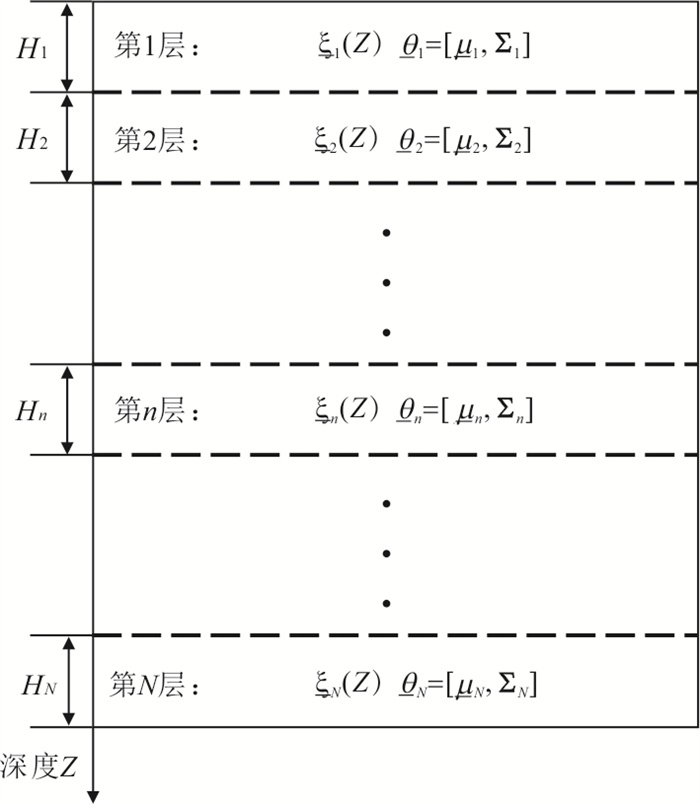
 下载:
下载:
